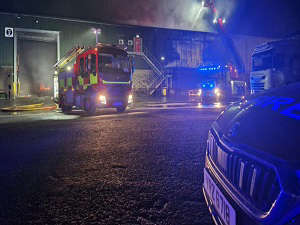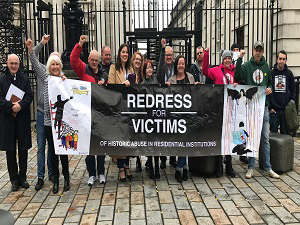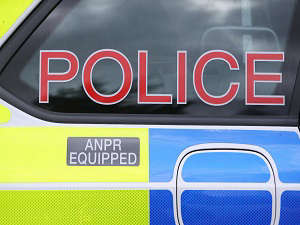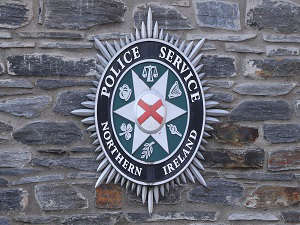
Q Radio News/PA
An order was given for soldiers to fire baton rounds as they were stoned by youths in Derry/Londonderry in 1973 shortly before a man was fatally injured, an inquest has heard.
Former soldiers who gave evidence at an inquest into the death of Thomas Friel, 21, contended they had been defending themselves.
Mr Friel died in hospital on May 20 1973, several days after the incident in the early hours of May 18 when he was hit by a rubber bullet in the Creggan area.
One of his brothers watched at Banbridge court house on Monday as two former soldiers gave evidence about the circumstances leading up to his fatal injuries.
Soldier B, who has been granted anonymity, was asked whether there was anything he would like to say to the Friel family, to which he responded: “I’m sorry it happened, I wish it hadn’t happened.”
A fresh inquest was ordered by Northern Ireland’s attorney general in 2014 after evidence emerged indicating that the Ministry of Defence knew of the lethal capacity of the projectiles.
Soldier D, who has been granted anonymity for the proceedings at Banbridge court house, was at that time serving with 3 Royal Anglian, based at Creggan Camp, also known as Piggery Ridge.
In his 1973 statement to Royal Military Police, which was read to the inquest, he was described as being second in command of a section commanded by Soldier A tasked to cover soldiers going out to mend wiring.
All were armed were SLR rifles while two – Soldier B and Soldier C – also carried baton guns, according to the statement.
The statement recalls people emerging from houses and started shouting “the usual abuse, ie British bastards” as well as blowing whistles, banging dust bin lids and car horns following a commotion when a man described a drunk was involved in an altercation with a soldier.
Crowds of “DYH” (Derry young hooligans) formed and stoned the soldiers.
They were dispersed but reformed several times as the patrol moved around the area. At one stage they were described as being stoned and bottled by 20-30 youths at which stage they were told us “use baton rounds if necessary”, according to Soldier D’s 1973 statement.
“I ordered my half section to withdraw after A’s section up, as we did so, this group followed us continuing to stone us, just before the track I told both men with baton rounds to open fire on the DYH, they fired two rounds each and I saw one man, aged about 25 years fall to his knees with his hands clasped to his chest, he was dragged away from the crowd,” the 1973 statement read.
Later the statement described the crowd of youths having grown to 50-60, and they stoned the soldier “heavily” at around 01.20am.
“As we withdrew the crowd began to follow us and still stoning us, I heard A give the order to fire baton rounds and I heard two bangs, I did not see any strike as I was facing the other way,” the 1973 statement read.

An army patrol in Northern Ireland in the 1970s
Michael Chambers, counsel for the coroner, said Soldier D made a second statement dated May 12, 2020.
It was also read to the inquest.
In the second statement Soldier D said he can’t remember many details of what happened on the night of May 17 to May 18 1973.
“My memory is poor due to the various health conditions which has resulted in four operations and I am still being treated for cancer of the liver and left kidney,” he said in the second statement.
He also said in the second statement he did not recall the man being hit by the rubber baton round, did not give any orders and cannot remember what orders he gave.
“I do not recall any baton rounds being fired that night or warnings being shouted using loud hailers or otherwise,” he added.
“I did not know about the death of Thomas Friel until I got the letter from the Coroner’s Officer.
“I do not remember making the statement to the Royal Military Police and I have not been interviewed by the RUC about this matter.”
During the inquest proceedings Mr Chambers asked Soldier D if he accepted the first statement was a statement he made in 1973.
Soldier D responded saying: “It could possibly be the statement I made in 1973, but I can’t remember.”
David Heraghty, acting for next of kin, questioned Soldier D on his statements.
Soldier D described being “constantly under attack”.
Soldier B, who was then a private with 3 Royal Anglian, also gave evidence from behind a screen.
In his 1973 statement he recalled carrying a baton gun, being ordered to fire it and firing two rounds to disperse the crowd of youths.
“I saw one youth struck on his leg by one round, he held his leg for a few seconds then ran back with the other youths into the alleyway,” he said.
In that statement Soldier B said he was again ordered to fire a round as a group youths advanced on the soldiers but said he was sure it didn’t strike anyone.
However, as rioters approached again he fired again at what he described in the statement as the “central leading figure”, and saw him fall on to his back.
“As we ran out from the track, I saw two other youths dragging the man back from the junction, the time was then about 0120 hours… the crowd began to stone us heavily to prevent us reaching the fallen youth,” his 1973 statement read.
Soldier B said he recalled being interviewed by the Royal Military Police after the incident, but didn’t remember much of what he had said.
Asked during the inquest proceedings by Mr Chambers had he been carrying a baton gun on the night in question, he declined to answer.
Inquest proceedings were moved from Derry/Londonderry to Banbridge court house in Co Down last week due to technical difficulties.
The inquest continues.


 Firefighters tackle large fire at Coleraine recycling plant
Firefighters tackle large fire at Coleraine recycling plant
 Institutional abuse survivors urged to come forward before deadline passes
Institutional abuse survivors urged to come forward before deadline passes
 Motorcyclist dies in County Antrim road accicent
Motorcyclist dies in County Antrim road accicent
 ATM stolen from Co Antrim service station
ATM stolen from Co Antrim service station
 IntoMedia Group Announces Charity Partner for 2025
IntoMedia Group Announces Charity Partner for 2025